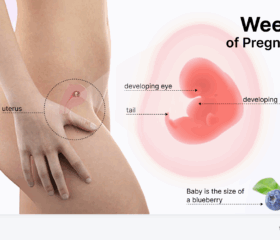Getting a Prenatal Massage While You’re Pregnant: Safety & Benefits
Pregnancy is a time of immense joy—as well as backaches, leg cramps, and headaches. If you're feeling drained and sore, a prenatal massage may be just what you need.

When done correctly, prenatal massage is a gentle, therapeutic way of relieving your pregnancy fatigue and discomfort. But like with any form of therapy during pregnancy, your and your baby’s well-being is the top priority.
Here’s how to safely enjoy the benefits of a prenatal massage, even at home.
What is a prenatal massage?
A prenatal massage is a specialized type of massage therapy focused on providing relief from the common aches and pains of pregnancy.
This type of massage can last anywhere from 15 minutes to over an hour.
What’s the difference between a prenatal massage and a regular massage?
Prenatal massage therapists are trained to make sure both you and your baby are safe and comfortable by avoiding potentially dangerous positions and areas on your body.
Generally, clinics or spas will use gentle massage techniques like: 1 2
- Swedish massage: This technique is defined by its use of kneading, long strokes, tapping, friction, and vibration. 3
- Myofascial release therapy: Your therapist will use gentle pressure to target the soft, connective tissue around your muscles, focusing on areas that are too tight. 4.
- Trigger point therapy: With this technique, massage therapists try to provide relief by targeting certain “trigger points” in your body. These are areas where your muscles are tightly wound like knots, causing hypersensitivity and pain. 5
Don’t be afraid to stop your therapist if something doesn’t feel right or if you need a break for whatever reason. Remember that a prenatal massage is supposed to be a relaxing experience, not a painful one.
How much does a typical prenatal massage cost?
Unfortunately, how much prenatal massage costs is highly variable. The cost depends on your location, the spa you pick, and the session length. You may also find discounted prices offered by universities that provide workshops for massage therapists, physical therapists, nurses, and other professionals involved in maternity care.
That being said, don’t skimp on your safety for the sake of saving a couple of bucks. Always go with a qualified professional trained in prenatal massage.
Your insurance might cover this type of massage
If you’re lucky, your insurance plan will cover doctor-prescribed massage therapy. If your doctor has suggested treating yourself, it never hurts to check with your insurance provider in case they’ll spot part or all of the cost.
When can you get a prenatal massage?
Usually, you can get a prenatal massage in your second and third trimesters. Some facilities offer them before then, but you might want to hold off on getting a prenatal massage too early on. Since the first trimester has a higher risk of miscarriage, many therapists prefer to wait until you’re further along. 6
Once you’re past the 12-week mark, you can enjoy a prenatal massage as often as your doctor says it’s safe.
How can a prenatal massage help you?
As well as giving you a well-deserved treat, there are plenty of reasons to get a prenatal massage:
Easing nerve pain
As your pregnancy progresses, you may experience one of the more uncomfortable side effects of carrying a tiny human: nerve pain due to sciatica.
This causes a numb, burning, or tingly feeling from your lower back down to your foot. Luckily for you, a prenatal massage can alleviate sciatica. 7 8
Reducing swelling
Your body retains more fluid than normal while you’re expecting, resulting in swollen feet during your pregnancy, along with swelling in your legs, ankles, and fingers. This is known as edema, and it often lingers for a while after birth, causing the postpartum swelling that many women experience. 9
A lymphatic massage—also known as manual lymph drainage (MLD)—shifts the buildup of those fluids away from affected areas, relieving your swelling. 10
In your second and third trimesters, you’ll usually start out with 15-minute sessions. However, you should avoid this type of massage in the first semester or if you’re still experiencing morning sickness—especially since nausea is one of the possible side effects. 11 12
Improving your mental health
If you’re feeling anxious, a gentle massage is a great way to calm your nervous system and boost your endorphin, dopamine, and serotonin levels. These effects can reduce symptoms of depression and alleviate the turmoil of pregnancy-related sleeping issues (i.e., pregnancy insomnia). 13 14
How can you keep safe while getting a massage?
It’s no secret that your body and baby are vulnerable during pregnancy. That’s why you’ll need to make sure to:
Check your therapist’s credentials
As mentioned, before booking an appointment, verify that your therapist is certified to give you a prenatal massage.
Check your state’s licensing board website to confirm their license and ask them about certifications specific to prenatal massage. Ideally, they’ll be certified by recognized organizations like the National Certification Board for Therapeutic Massage & Bodywork (NCBTMB).
You can also research their experience working with other pregnant clients through online reviews.
Get a premassage consultation
Before your massage, your therapist should ask you a few questions. They’ll usually ask about your pregnancy, any discomforts you’re experiencing (like lower back pain, rib pain, swelling, or leg cramps), and your overall health.
This is a good time to let them know about any conditions you have that might affect your message experience, such as if you have diabetes and need to monitor your sugar levels.
Your therapist may also require written or signed consent from your doctor, and they may ask you to sign a waiver, which should highlight the potential risks of the massage. Make sure you read through this carefully before signing.
Avoid certain positions during your prenatal massage
Lying flat on your back can pinch the vena cava, the major vein that carries blood to your heart and your baby. If you need to lie down, try doing so on your left side to promote blood flow. Use as many pillows as needed—under your head and belly, as well as between your thighs. 15 16
In the later stages of pregnancy, you should avoid lying on your stomach. Some massage tables have a small divot or hole to accommodate your stomach while lying down, which some women prefer, but others still find it uncomfortable to have their stomach confined or hanging in this position.
If neither of these positions works for you, try lounging in a semi-reclined posture with enough pillows supporting your back. If you struggle with acid reflux, sitting upright will probably be better for you than lying facedown or on your side.
Avoid certain areas during your prenatal massage
Generally, you’ll want to avoid putting any kind of firm pressure on your stomach, although there’s nothing wrong with lightly touching or stroking your baby bump.
You should also steer clear of pregnancy-induced varicose veins or areas where blood clots can form, such as your legs and pelvis, as you risk dislodging them with a massage. This can happen even with a technique that uses only light pressure, like a lymphatic drainage massage. 17 18
When blood clots break free and travel through the circulatory system, they can potentially shut down your heart, lungs, and other organs by causing blockages. 19
Unfortunately, you’re five times more likely to develop clots during your pregnancy and delivery—as well as within the first three months postpartum. 20 Be careful with massages even after you give birth.
If you have type 1 diabetes, avoid massages over the injection points, as this may lower your blood sugar levels. 21 You’ll need to monitor your glucose levels before, during, and after your session.
Your therapist may also avoid your wrists, hands and ankles
Some prenatal masseuses avoid these areas due to the folk belief that these pressure points may stimulate contractions. This claim doesn’t have a scientific basis—skirting those areas actually won’t hurt you, but there’s no evidence that it’s necessary.
When prenatal massage may be unsafe
While it’s generally safe, prenatal massage can affect your blood flow, which may be dangerous if you have high blood pressure, congenital heart disease, or preeclampsia. You should also postpone your prenatal massage if you have complications like a recent injury or organ transplant. 6
You should also double-check with your doctor about using vibration massagers and chairs, as well as other techniques that may be too much for you, like deep tissue and hot stone massages. In fact, as a rule of thumb, it’s best to run anything new you’re planning on doing to your body by your doctor, just in case.
Can you enjoy a prenatal massage at home?
You don’t always need to break the bank to experience the benefits of a massage. So long as you avoid problematic positions and areas as outlined above, you can treat yourself to a prenatal massage in the comfort of your own home.
Recruit your partner, friend, or relative and settle in for a relaxing at-home experience. While they may not know the fancy techniques professionals use during prenatal massages, they can still give you much-needed relief.
How to get a prenatal massage at home
To get started, use supportive cushions and pillows to ensure you’re comfortable and properly aligned, especially when lying on your side.
If you enjoy aromatherapy, opt for pregnancy-safe options like lavender, chamomile, jasmine, and eucalyptus. 22 Always check for sensitivities and avoid oils not recommended during pregnancy, like camphor or aniseed. 23
Once you’re all set, your impromptu massage therapist can offer whatever type of massage you like, whether it’s a foot, back, or shoulder massage. Just be sure to avoid those danger zones we mentioned above.
Take breaks when you need to, whether you’re at home or in a professional spa. It’s okay to stretch or drink a glass of water if you feel like you’re getting overwhelmed. Remember to take it easy after your massages as well.
Final thoughts
With everything you’re going through during pregnancy, you deserve a little extra pampering. So long as your doctor agrees, prenatal massages are the way to go.
Whether you decide to book that fancy spa day or want your partner to crack open the massage oil at home, a prenatal massage will give you a much-needed reprieve from the discomforts of pregnancy.
Article Sources
- Gwinnett Colleges and Institute. "What Are Some Massage Therapy Techniques?" Retrieved April 24, 2025.
- Corewell Health. "Pregnancy Pain Management" Retrieved April 24, 2025.
- American Institute of Clinical Massage. "Swedish Massage - The Complete Guide" Retrieved April 24, 2025.
- Cleveland Clinic. "Myofascial Release Therapy" Retrieved April 24, 2025.
- American Massage Therapy Association. "Massage and Trigger Points" Retrieved April 24, 2025.
- The University of Texas Southwestern Medical Center. "Is massage safe during pregnancy?" Retrieved April 24, 2025.
- Healthline. "Pregnancy Sciatica: 5 Natural Ways to Find Pain Relief Without Drugs" Retrieved April 24, 2025.
- Penn Medicine Lancaster General Health. "Sciatic Nerve Pain During Pregnancy" Retrieved April 24, 2025.
- National Health Service. "Swollen ankles, feet and fingers in pregnancy" Retrieved April 24, 2025.
- International Wound Journal. "Effectiveness of manual lymphatic drainage vs. perineal massage in secundigravida women with gestational oedema: A randomised clinical trial" Retrieved April 24, 2025.
- Southern California Health Institute. "10 Benefits of Lymphatic Drainage Massage" Retrieved April 24, 2025.
- University of Michigan. "Lymphatic Massage" Retrieved April 24, 2025.
- Cleveland Clinic. "Prenatal Massage Benefits and Safety" Retrieved April 24, 2025.
- NorthwestCareerCollege. "Massage Therapy and Its Impact on Mental Health" Retrieved April 24, 2025.
- University of Rochester Medical Center. "Sleeping Positions During Pregnancy" Retrieved April 24, 2025.
- The University of Texas Southwestern Medical Center. "Be safe when pampering yourself during pregnancy" Retrieved April 24, 2025.
- American Institute of Alternative Medicine. "How to Do Lymphatic Drainage Massage? Tips & Techniques" Retrieved April 24, 2025.
- American Society of Hematology. "Blood Clotting & Pregnancy" Retrieved April 24, 2025.
- YaleMedicine. "Blood Clots in Veins, Heart and Lungs" Retrieved April 24, 2025.
- U.S. Centers for Disease Control and Prevention. "Data and Statistics on Venous Thromboembolism" Retrieved April 24, 2025.
- American Diabetes Association. "Is Massage Useful in the Management of Diabetes? A Systematic Review" Retrieved April 24, 2025.
- University of Wisconsin Integrative Health. "Integrative Approaches to Common Complaints in Pregnancy" Retrieved April 24, 2025.
- International Childbirth Education Association. "The Safe Use of Essential Oils" Retrieved April 24, 2025.







